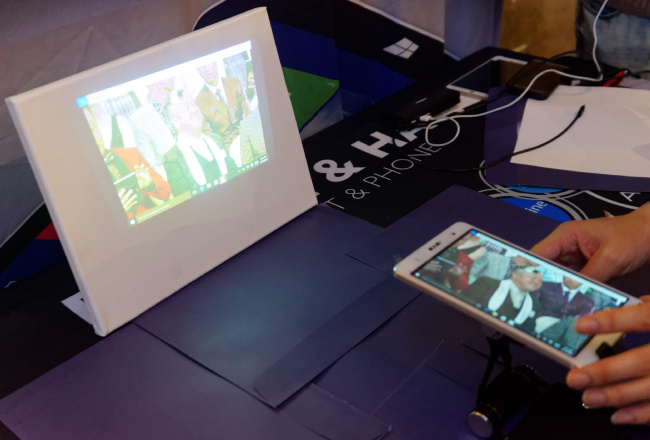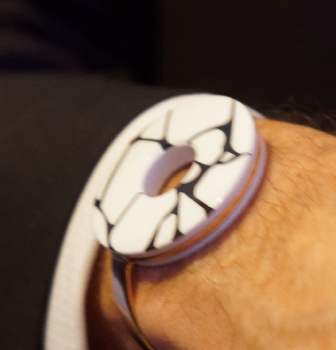On the Sunday before the official start of the MWC show, Showstoppers held its annual “meet the vendors” event and we went along. We didn’t think that there were as many companies of interest as the later Digital Focus event, but we found some interesting people to talk to.
Akyumen is a US, privately-owned company that was garnering some interest for its pico-projector equipped tablet and phone. Output from the Hawk Prime (octacore/4GB RAM/300G flash) and Hawk Dimension (10 core/GB RAM/300GB flash) phones was quoted to us as 35 lumens, although the company’s press material says 45+ lumens (and we were told that it would be 90 lumens later in 2016). The phones run Android. The Falcon M tablet has similar memory specifications to the Prime phone, but uses an Intel quad core processor and runs both Windows and Android and can flip between the two operating systems. There is also a Falcon Edu version of the tablet for education. The projection system is also the DLP/LED system that is used in the phones and which has 720P resolution. The products are due to start shipping in Q2 2016.

Amino Communications is a name we know from our work in TV – the company started in IPTV and in helping to deliver QoS over IPTV. Last year, the company acquired BooxMedia and is now working on a cloud TV platform that can be adopted and branded by TV operators for free or PPV content. The company is also interested in offering a cloud-based PVR with features such as a “backward-looking” EPG. We made the comment that cloud-based PVRs should be simpler, as you really only have to store one copy of the content and have a pointer for any user that has accessed it and to show how much has been seen. However, Amino told us that because of the way that rights contracts are written, it is not unusual to have to store an individual copy of the content for each user!
FLIR Systems produces the rugged CAT phones, and was showing a new model called the CAT S60. Designed specifically for tradespeople, the phone features an integrated thermal imaging camera. It can be used in a similar way to the peripheral from Seek Thermal (Digital Focus is All About Cameras), i.e. to detect faulty plugs and wiring, find wall studs, etc. The camera can be used to capture both still images and video, and has a range of around 30m.
The S60 phone is waterproof to depths of 5m for one hour (the phone’s regular 13MP rear camera can also be used underwater), and meets the MIL-STD-810G specification; it can survive 1.8m drops on to a hard surface. The 4.7″ (1280 x 720) display features a touch overlay which can be operated by wet or gloved fingers. An octa-core Snapdragon processor (with 3GB of RAM and 32GB of ROM) runs Android 6.0. Typical brightness is 540 cd/m². FLIR will release the phone in June, for $600.
The Eye Tribe, which is a specialist start-up in gaze recognition and eye-tracking was at the event and talking about our favourite “buzz phrase” of the moment, ‘foveated rendering’. (This means using gaze recognition to calculate where the viewer’s eye is looking and using that information to calculate where the rendering needs to be best. Other regions can be rendered with lower quality, but saving power – important in VR). The firm had a very “hand made” tracking solution that was fitted around the lens inside an Oculus Rift headset (it was broadly similar to a more polished one that we saw from SMI at MobileFocus). One of the issues in making this work is speed – the eye makes a lot of small motions at high speed and the gaze needs to be able to cope with this. The Eye Tribe told us that can track at 300Hz, which is plenty fast enough. The foveated rendering is still at a fairly early stage and we thought that it wasn’t difficult to notice artefacts and visual differences between the area being gazed at and the rest of the image.
 Jacob Jensen Design is a Danish design company that was showing its Halo “Smart Bracelet”. The device is intended to be appealing as a fashion item and focusses on one purpose – emergency safety for women. The device pairs with a smartphone by bluetooth and can transmit a pre-defined SOS message to an assigned contact with three taps on the device.. It can also offer other functions using gestures, such as triggering a call, taking a picture or starting to play or record sound. It is waterproof and the battery lasts four weeks. A range of different covers and designs is available. There’s a video at http://tinyurl.com/zmcmucy
Jacob Jensen Design is a Danish design company that was showing its Halo “Smart Bracelet”. The device is intended to be appealing as a fashion item and focusses on one purpose – emergency safety for women. The device pairs with a smartphone by bluetooth and can transmit a pre-defined SOS message to an assigned contact with three taps on the device.. It can also offer other functions using gestures, such as triggering a call, taking a picture or starting to play or record sound. It is waterproof and the battery lasts four weeks. A range of different covers and designs is available. There’s a video at http://tinyurl.com/zmcmucy
![]() Mio’s HRM tracker uses LEDs for its displayMio was showing its HRM watch system which it was emphasising can be used for all day activities and which tracks heart rate as well as simply counting steps without needing a chest strap. There are versions for cyclists ($79 and with no display) and for runners with an LED display at $199.
Mio’s HRM tracker uses LEDs for its displayMio was showing its HRM watch system which it was emphasising can be used for all day activities and which tracks heart rate as well as simply counting steps without needing a chest strap. There are versions for cyclists ($79 and with no display) and for runners with an LED display at $199.
Vizmato is the developer of a real time and mobile video editing application that can apply special effects or be used to process and publish videos. A wide range of special effects and looks are available. The company claims four million users on iOS and is developing for Android in the future.

